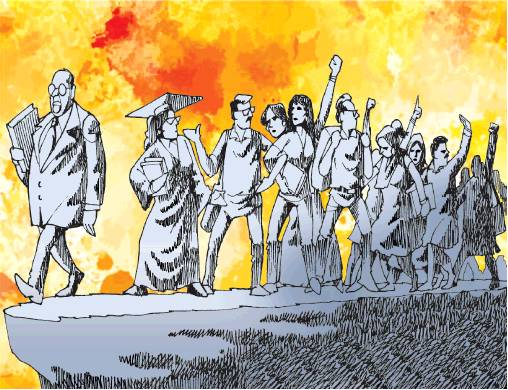Pavan K Varma
The BJP, especially after Narendra Modi became prime minister, has prided itself on a certain muscular nationalism, ‘distinct’ from other mainstream political parties which are seen as ‘soft’ on the core issue of ‘national pride’. The party believes that only it has the right level of respect for ‘national’ symbols, as also the self-ordained right to define what is appropriate patriotic behaviour.
This appropriation of nationalism has, however, received a rude shock in the last few months, ever since the anti-CAA-NRC protests began on a pan-Indian scale. Students in universities across the country have joyously, consciously and spontaneously taken over the celebration of the very nationalist symbols that BJP thought it had a monopoly to protect. For the young in India, irrespective of caste or creed, the national flag has become a much loved symbol of protest. The national anthem has become a highly respected revolutionary song of choice. And, the Constitution has become the very emblem of national pride, the one guarantor in the secular realm of the very idea of India.
This can be verifiably seen in the protests unfolding in manifold places across the country. Tricolours of all sizes and in huge numbers are proudly held aloft by protesters wherever they congregate. Protest meetings are notable for the mass and full-throated singing of the national anthem. Students gather in large numbers to do nothing else than to emotionally read the Preamble of the Constitution.
The entire notion of ‘Indian-ness’ has been hijacked by the protesters. True patriotism is defined as loyalty to the country on terms defined by the Constitution, without being divided – as BJP is perceived to be trying to do – by labels of sectarian or religious identity. BJP’s slogan of ‘akhand Bharat’ has been subsumed by young India in their assertion of the unity and sovereignty of India as a bipartisan responsibility of every citizen. Anyone seeking to subvert this laudable goal by redefining citizenship itself, on the basis of religion, is acting against the national interest.
Countless examples can be given to illustrate this improbable reversal of roles. But let me just cite some incidents in the capital of the Republic. On January 26 this year, Republic Day was celebrated at Shaheen Bagh in New Delhi, where anti-CAA-NRC protests have now been on continuously for over 40 days, by a mass celebration of the tricolour, the national anthem and the Constitution. Efforts went on for the whole night before Republic Day in preparing for the grand unfurling of the national flag, with great care being taken to put flower petals inside the flag and folding it accordingly.
There was an overarching message too in the manner in which the flag was unfurled. That message was that the Republic must be venerated for its grand transcendence of sterile and unacceptable divisiveness, and that the Republic alone is the best guarantor to counter, through the Constitution, those who seek to ignore the solemn commitment to liberty, equality, justice and fraternity. Thus, the 55-feet-high tricolour was unfurled by three women, ‘dadis’ or grandmothers, because of their advanced age. One of the three was a Hindu, Radhika, the mother of Rohit Vemula, the Dalit student who committed suicide in a university in Hyderabad due to caste oppression. Another was a Muslim, Saira Bano, the mother of Junaid Khan, a victim of hate lynching.
Not far away in Jamia, protesters read the preamble of the Constitution in Hindi, English and Urdu, enthusiastically hoisted the national flag, and sang the national anthem with gusto. Some students also created tableaux on themes of patriotism, national unity, equality and women’s rights, and took them out in a parade from Jamia to Shaheen Bagh on e-rickshaws.
For the leaders of BJP, who have chosen to label all protesters as antinational anarchists and traitors, while insidiously – and inaccurately – projecting them as being only from a certain community, this has been an unexpected rejoinder. Those whom they were accusing of lacking in ‘nationalist’ sentiment, are now, through their nationalist actions, questioning the nationalist credentials of their accusers.
In fact, they are going beyond doing that. They are privileging the fact of being Indian first over narrower loyalties, and also constructively redefining patriotism in conformity with progressive principles of finding ‘azadi’ or freedom from inequality, exploitation, violence, and divisiveness, a marked difference from the superficial, aggressive and lumpen nationalism that many of the ultra-right revel in.
There is also in this ‘new’ nationalism the spectacular appropriation of iconic figures of the freedom movement, and especially Mahatma Gandhi and Ambedkar. In the context of the deliberate attempt to polarise the protests on communal lines, Gandhi is valourised as the ultimate messiah of national unity, social harmony and respect for all faiths. And, Ambedkar is seen as the visionary drafter of the Constitution, which is a guarantor for freedom, dissent and justice.
How will the party in office react to this counter narrative of patriotism that directly challenges its assumed monopoly over nationalism? One can only hope that with the nationalism card taken away, there is no further resort to mindless or excessive violence by ultra-right elements, and law enforcement agencies, of which, unfortunately, we have already seen disturbing evidence.
The writer is an author and former diplomat


February 2, 2020 at 7:13 pm
The protesters have shown that true patriotism lies in upholding constitutional values and following gandhi and ambedkar ideals